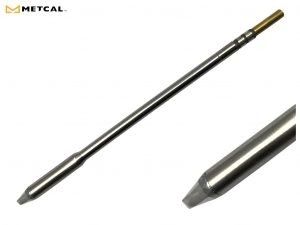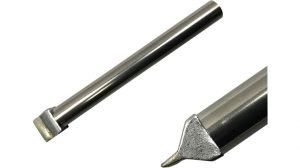Tips to Choose The Right Soldering Tip
Published date: 01 April 2021

When buying or upgrading an soldering iron, there are various soldering tip styles to choose from. The various shapes each have their own benefits, and some are more powerful than others when used for a specific application. Let’s take a look at the most popular types of solder tip designs as well as some solder tip fundamentals.
Soldering Tip Basics
One of the most critical aspects of choosing a solder tip is ensuring that it is the correct size for the intended job. A small tip will not be effective in transmitting heat to the job, resulting in a frustrating soldering attempt and weak solder joints.
A tip that is too big can transfer too much heat to the job. This has the potential to damage both the pad and the part. In certain situations, a large tip with a high heat transfer rate can also damage the circuit board, causing problems.
If you are buying tips for an existing solder station, make ensure that the tips are built to match and operate with your equipment. Some tips are intended for heavy-duty use, while others are intended for light-duty and precision work.
Some soldering solutions, such as Metcal’s SmartHeat Technology, should be used with the necessary tips and cartridges to ensure proper operation. Using the right tips and cartridges is one way to ensure that your soldering equipment works optimally.
#1: Chisel Tips Are a Versatile Choice
Chisel tips are the most popular tip shape, and they are useful for a wide range of soldering tasks. The wide edge of chisel tips helps them to spread heat uniformly through part leads and pads.
The chisel tip is an excellent choice for a variety of applications. Most chisel tips have a tapered edge that allows it to get in between components as required. They are ideal for cables, pass-through connections, wider surface mount components, and a number of onboard connections.
When paired with a tool for extracting the material, a chisel tip is often useful for many de-soldering tasks. The tip should ideally be scaled to fit the pad being soldered without overheating the components. A good rule of thumb for chisel tips is to aim for 60% of the pad size, or slightly more than half.

#2: Conical Tips Are Best for Precision Work
Most conical tips have a pointed shape and are mainly used for precision soldering. The cone-shaped tip concentrates heat to a small area, making it suitable for most surface-mount components and other small tasks.
The cone shape enables the conical soldering tip to reach areas that other tips can find difficult to reach. As a consequence, having a conical tip on hand for those difficult-to-reach places is always handy.
When using a conical tip, beginners or those new to soldering should exercise caution. Sharper points are more vulnerable to damage than other tip designs, so they must be treated with care. Many beginners use too much force on the soldering tip, which can damage both the tip and the work with a conical tip.
Conical tips are commonly used in wire connector applications where space is small. The tip’s shape enables it to reach into the connector where other tips might be too big.

#3: Hoof Tips Can Handle Larger Amounts of Solder
The hoof tip design is less popular than the conical and chisel tip designs. Since the surface of the hoof tip can accommodate more solder than other tip designs, it is an excellent option for applications requiring a pre-loaded tip.
The hoof tip is designed with a slight concave impression on its back. In certain applications, this helps the tip to spread solder. The hoof tip can also be used to gather excess solder when working on a project.
Hoof tips are useful for drag soldering several surface mount part pins at the same time. Drag soldering is a method for quickly soldering several pins, and it must be done with caution to avoid pin bridges.
Hoof tips are very useful for soldering small gauge wire and other applications where the solder loaded on the tip is sufficient to make the connection since they can be loaded with solder. The hoof tip will save time when used in this manner.

#4: Knife Tips Have a Useful Edge
The knife tip has an edge shape that allows it to reach slotted cavities that other tip designs cannot. It’s ideal for multi-lead applications and J-leaded components like PLCCs and DRAMs. The knife tip’s slanted edge is also suitable for fixing solder bridges.

#5: Blade Tips Can Be Time Savers
The blade tip is broader and wider than the tips on most soldering irons. Blade tips are commonly used for rework and pad cleaning. They are very effective at extracting solder from several pads at once when combined with soldering braid and tacky flux, saving time.

When it comes to hand soldering, the right solder tip will make all the difference. We stock a wide range of tips and cartridges designed to improve the efficiency of your work. Please contact us to see if we can assist you with your soldering, desoldering, and reworking requirements.




Comments
There are currently no comments, be the first to comment.